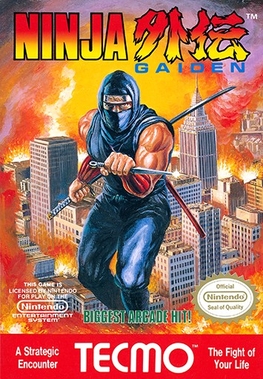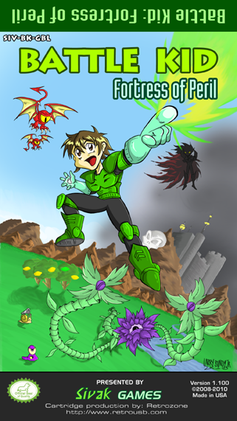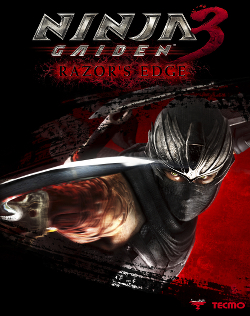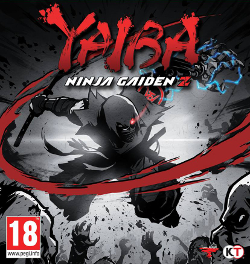Ninja Gaiden is a media franchise based on action video games by Tecmo featuring the ninja Ryu Hayabusa as its protagonist. The series was originally known as Ninja Ryukenden in Japan. The word "gaiden" in the North American Ninja Gaiden title means "side story" in Japanese. The original arcade version, first two Nintendo Entertainment System games and Game Boy game were released as Shadow Warriors in PAL regions. As of 2008, the series has shipped over 7.7 million copies.

Ninja Gaiden III: The Ancient Ship of Doom is a side-scrolling platform video game developed and published by Tecmo. It was released in Japan on June 21, 1991 for the Famicom and in North America on August 1991 for the Nintendo Entertainment System (NES). The NES version was not released in Europe. It was later ported to the Atari Lynx by Atari Corporation and released in 1993 in North America and Europe, the European version retaining the North American Ninja Gaiden III title. It was also re-released as part of its Ninja Gaiden Trilogy Super NES compilation in 1995 in Japan and North America. Long after, it was released for the Virtual Console service in North America on February 18, 2008 for the Wii and in North America and Europe on November 28, 2013 and January 23, 2014 respectively for the Nintendo 3DS. It was designed by Masato Kato, who took over for Hideo Yoshizawa—designer of the first two games in the NES series.

ClayFighter is a fighting game released for the Super NES in November 1993 and ported to Sega Genesis in June 1994. The game is a parody of Street Fighter. In 2009, the Genesis version was re-released on the Wii Virtual Console.

Ninja Gaiden is an action adventure hack and slash video game developed by Team Ninja and published by Tecmo for the Xbox. It was released in March 2004. Set in the futuristic version of the 21st century, players control Ryu Hayabusa, a master ninja, in his quest to recover a stolen sword and avenge the slaughter of his clan. It was inspired by Tecmo's Ninja Gaiden series, and is set in the same continuity as Team Ninja's Dead or Alive fighting games.

Ninja Gaiden, released in Japan as Ninja Ryūkenden and as Shadow Warriors in Europe, is an action-platform video game developed and published by Tecmo for the Nintendo Entertainment System. Its development and release coincided with the beat 'em up arcade version of the same name. It was released in December 1988 in Japan, in March 1989 in North America, and in August 1991 in Europe. It has been ported to several other platforms, including the PC Engine, the Super NES, and mobile phones.

Ninja Gaiden is a side-scrolling, hack & slash, platform-action video game developed by SIMS and released by Sega for the Master System in 1992, with license from Tecmo.

Bit.Trip, stylized BIT.TRIP, is a series of nine video games developed by Choice Provisions and published by Aksys Games for the Wii, Nintendo 3DS, Microsoft Windows, macOS, PS Vita, and PS4. It was published by Arc System Works for WiiWare and Nintendo eShop in Japan, and by Namco Networks America Inc for the iPhone, iPod Touch and iPad. Each game revolves around the adventures of a character named "Commander Video", and features "a crazy mix of 80s aesthetics and modern game design". The styles of the games range from pong-like, to platforming, and shooting. Each game in the series features a chiptune-inspired soundtrack, but a different style of rhythm-based gameplay in each. Most games in the series have few levels; Beat, Core, Void and Flux have only three levels each while Fate has six and Runner has 36. Most of the games feature levels lasting between 10 and 25 minutes to make up for having such few levels. The games also consists of 8 modes; Nether, Hyper, Mega, Super, Ultra, Extra, Giga, and Meta; which changes based on how well the player does. Each successive game adds a new mode, the highest being Mega in Beat, and Meta in Flux.

Super Meat Boy is a 2010 platform game designed by Edmund McMillen and Tommy Refenes under the collective name of "Team Meat". It was self-published as the successor to Meat Boy, a 2008 Flash game designed by McMillen and Jonathan McEntee. In the game, the player controls Meat Boy, a red, cube-shaped character, as he attempts to rescue his girlfriend, Bandage Girl, from the game's antagonist Dr. Fetus. The gameplay is characterized by fine control and split-second timing, as the player runs and jumps through over 300 hazardous levels while avoiding obstacles. The game also supports the creation of player-created levels. Super Meat Boy was first released on the Xbox 360 through Xbox Live Arcade in October 2010, and was later ported to Microsoft Windows, OS X, Linux, PlayStation 4, PlayStation Vita, Wii U, and the Nintendo Switch. A Wii version was in development but was ultimately cancelled.

Battle Kid: Fortress of Peril is a platform game for the Nintendo Entertainment System released in February 2010 by American developer Sivak Games. It is published through Retrozone with the cover art designed by Larry Bundy Jr. Battle Kid is available for purchase on the Xbox store, the Nintendo Switch eShop, and as a game ROM or physical cartridge for the NES.
Super Mario Bros. Crossover is a fan-made crossover platform Flash video game launched on Newgrounds on April 27, 2010 by Exploding Rabbit. It is based mostly on the gameplay of Nintendo's Super Mario Bros. for the NES. The only major difference is the ability to control characters that debuted in other Nintendo Entertainment System games unrelated to the Mario series, plus the ability to use "skins" of levels and characters from other games and platforms. The latest version available (3.1.21) was released on December 27, 2013.

Ninja Gaiden 3: Razor's Edge is a 2012 action adventure hack and slash game developed by Team Ninja and published by Nintendo. It was released for the Wii U from November 2012 to May 2013, and subsequently released by Tecmo Koei for the PlayStation 3 and Xbox 360 in April 2013. It is an enhanced port of Ninja Gaiden 3 that includes all downloadable content from the original title, as well as additional enhancements made to improve the game. The game can be considered an equivalent to the Ninja Gaiden Sigma games, as it makes several changes to the original title.

The Wonderful 101 is an action-adventure game developed by PlatinumGames and published by Nintendo for the Wii U. The game was directed by Hideki Kamiya and produced by Atsushi Inaba. It was released in August 2013 in all major regions except North America, where it released the following month. The Wonderful 101 received generally positive reviews. It failed to meet sales expectations.

Yaiba: Ninja Gaiden Z is an action adventure hack and slash game, and a spin-off of the Ninja Gaiden franchise. It was published by Tecmo Koei and developed by Spark Unlimited. Comcept's Keiji Inafune conceptualized the game, providing character designs and creating the character of Yaiba. The game was released for the PlayStation 3, Xbox 360, and Microsoft Windows worldwide in March 2014.
Level-5 Comcept, formerly known as Comcept Inc., is a Japanese video game developer company based in Osaka, founded on December 1, 2010 by Keiji Inafune, formerly of Capcom.

Geometry Dash is a side-scrolling music platforming game series developed by Robert Topala. The game was released on 13 August 2013 on iOS and Android, and the Windows and macOS versions on 22 December 2014. In Geometry Dash, players control the movement of an icon and navigate music-based levels while avoiding obstacles such as spikes.

Gunman Clive, released in Japan as Gunman Story, is a platform game developed and published by Swedish development studio Hörberg Productions. It was first released for Android on 2 April 2012. The game follows Clive, a lone gunslinger in a futuristic Wild West, as he tries to save the mayor's daughter from a group of technologically well-armed bandits.
"Nintendo hard" is extreme difficulty in video games with trial-and-error gameplay and limited or nonexistent saving of progress. The enduring term originated with Nintendo Entertainment System (NES) games from the mid-1980s to early 1990s, such as Ghosts 'n Goblins (1986), Contra (1988), Ninja Gaiden (1988), and Battletoads (1991).
Masocore is a video game subgenre with a focus on intense difficulty, often featuring complex or unfair mechanics. The name is a portmanteau of "masochism" and "hardcore", suggesting that players of the genre are hardcore gamers who find pleasure in the aggravation required to beat the games and the feeling of reward afterwards for having surpassed a seemingly insurmountable challenge. Masocore games are mostly 2D sidescrollers, harkening back to retro Nintendo hard platformers, although the definition can also be taken to encompass fully 3D games of high difficulty such as soulslikes.












